Derby Lightweight (Yellow Diamond) 1, 2 & 4-car DMUs
The Buckingham - Banbury Experiment
On August 13th 1956 two single car Derby Lightweights were introduced on the 16 ¾ mile Buckingham to Banbury (Merton St) branch. The line, threatened with closure since 1952, was operating at a £14,000 annual loss. The experiment with a the single vehicle train was to try to avoid the withdrawal of passenger facilities and to assess the suitability of such vehicles for other lines where passenger traffic was light.
Two intermediate halts (Fullwell & Westbury and Branchley Town) scheduled for closure were kept open, and two unmanned halts (Radclive and Water Stratford) were added. The guard issued tickets for these stops to avoid the expense of station staff.
The experiment, which was two years before the introduction of the smaller four-wheel raibuses, was internally declared a failure after just three months despite cutting operating costs and a 400% rise in receipts. The move to withdraw the service was protracted, finally ending on December 31st 1960.[1]
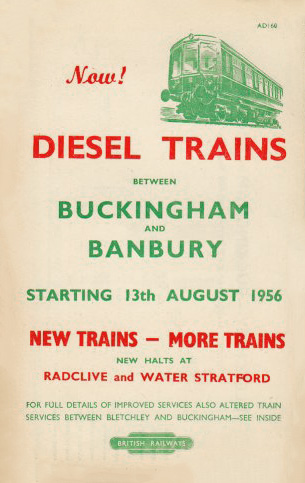
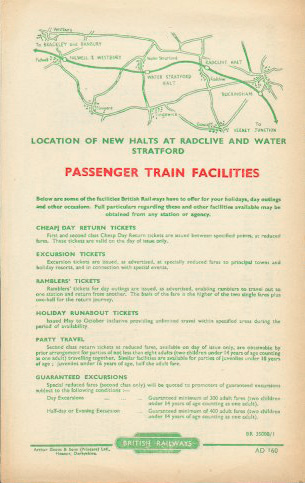
Conception
Details of how this scheme came about can be found in the minutes of the Diesel Light Weight Trains Committee (LWTC) under the topic 'Rail Cars for Rural Areas'. The time between the first mention of the experiment and the implementation was just six months, a very short period when compared to other schemes which normally took well over a year.
At the meeting on the 8/9th February 1956 there was a discussion around a request to perform an experiment with a single unit vehicle similar to what was operating on the Continent. The same idea would eventually evolve into plans for the 22 railbuses some time later. For the experiment it was envisaged that the stations would not be staffed as the guard would issue tickets, the vehicles would stop at crossings and halts, and ideally it would be on a line already closed without signalling. Several lines were suggested, although not the Buckingham - Banbury branch.
The use of the Buckingham - Banbury branch was raised at the following meeting on March 15, apparently suggested by the Region's General Manager. Running to Bletchley was not an option (although the two vehicles anticipated for the service would be based there), but consideration would be given to running to Verney Junction on the Oxford - Cambridge line. The committee authorised one vehicle to be constructed at Derby at a cost of £300 more that a regular power car to provide the additional cab equipment and seats, making the total cost for the vehicle £15,500. This was to be constructed from a vehicle already scheduled to be built for the LMR for the Manchester Part 1 scheme.
The second vehicle was authorised at the April 30th meeting, to be built 'as a spare'. The size of the guards van on the first vehicle was felt to be too small, although it was too late to change as most of the work was done and the vehicle would be complete in less than five weeks on June 4th. The rear of the vehicle had the same saloon / van arrangement (A1 type) as the West Riding and West Cumberland brake vehicles, but the additional cab reduced the van length from just under 10ft to only 5ft 6in. The second vehicle would be constructed based on the A3 type arrangement without the small saloon at the rear reducing seating by nine.
The same meeting discussed the finances of the branch. The annual operating costs were currently £15,000, and the diesels would reduce this to £11,000. The annual revenue from the line was £618 and it was estimated that the diesel service would bring in an additional £1,500 per annum, no doubt based on the huge increases in passenger figures the introduction of DMUs had created in other areas. The construction of two halts at Radclive and Water Stratford was authorised at a cost of £500 since it was estimated these would bring in an estimated £380 of revenue per year.
By the next meeting on June 7th delivery date of the first vehicle had slipped to the end of June, the second was expected in July. Commencement of the diesel service was agreed as August 13th.
The service
Only one vehicle was required to provide the service each day, the two vehicles would normally work on alternate days. Sets of portable wooden steps were used at Banbury, Brackley and Buckingham due to the low platforms. Banbury Merton Street was repainted for the launch. The two new halts consisted of a normal height wooden platform (recycled sleepers) with ramps at each end and fitted with oil lamps.
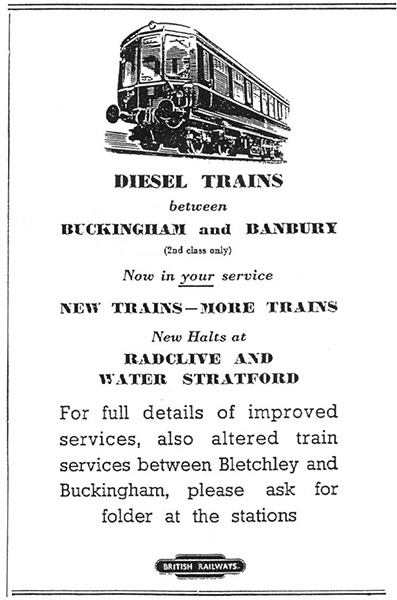
The stops in order were were Buckingham, Radclive Halt, Water Stratford Halt, Fullwell & Westbury, Brackley, and Banbury (Merton Street). A map of the branch (and many images of the vehicles in service) can be found on the Disused stations website. The first timetable did not include Verney Junction, but did have one through return to Winslow and the last departure from Banbury running through to Bletchley. Many, but not all, had connections at Buckingham with the steam push-pull service to Bletchley.
The diesels departed Banbury (Merton St.) for Buckingham at 7.08am (arr. 7.39am, Bletchley connection at 7.49am), 8.54am (arr 9.26am, Bletchley connection at 9.35am), 11.05am (to Winslow, arr. 11.51am), 1.30pm (arr. 2.01pm), 3.45pm (arr 4.16pm, Bletchley connection at 4.24pm), 5.25pm (arr 5.56pm) and 7.00pm (to Bletchley, arr. 8.08pm). Arrivals at Banbury Merton St. were at 8.46am (8.15am from Buckingham), 10.03am (9.32am from Buckingham), 1.17pm (12.33pm from Winslow), 3.26pm (2.55pm from Buckingham), 4.53pm (4.22pm from Buckingham) and 6.41pm (6.10pm from Buckingham).
As the daily diagram ended at Bletchley but began at Banbury there was presumably an ECS move in the morning. The timetable had some fast turnarounds of six minutes but as a turnaround just involved the driver and guard walking 56ft - changing cabs, moving the tail lamp (and maybe a toilet stop) - this was more than adequate but left little recovery time.
First Days
The last day of regular steam was Saturday 11th August 1956 since there was no Sunday trains.
M79901 worked the first day of diesel services on Monday 13th and the loadings showed lots of promise. The 1.17pm arrival at Banbury was full with about six standing. The 1.30pm departure left with about 20 passengers and picked up another six at Water Stratford and two at Radclive. The 3.26pm arrival at Banbury was also full with several people standing, reached a speed of 63mph approaching Banbury.[2]
There was an engine failure during the first week but the vehicle was able to continue working on one engine until fitters arrived. A vehicle used about 56 gallons of fuel per day, working out at about 5 miles per gallon. Even at this early stage there were criticisms. One was the absence of a connecting service to Bletchley from the 1.30pm from Banbury to Buckingham (the previous steam timetable had a train from Banbury to Bletchley at 1.42pm), another was the lack of toilets on the trains.
The Lightweight Trains Committee met that week, on the 17th, happily reporting that for the first four days receipts were £86 compared with £35 for the same four days the previous year. There were concerns expressed about the alternating use of the vehicles as this would mean mean scheduled maintenance and tyre turning would be due for both at the same time. It was also noted that the small van on M79900 was already causing trouble. At some point the vehicle would go to Derby Works where the small saloon was removed and the van enlarged by moving the partition to match M79901.
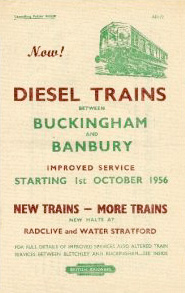
Improved Services October 1956
After just six weeks a revised timetable was put in place. From the 1st October the improved service had three trips each way between Bletchley and Banbury and four each way between Buckingham and Banbury. The mid-day through diesel working to Bletchley allowed the vehicles to be changed over and refuelled between 12.05pm and 12.30pm[3]. The 1.30pm ex-Banbury now connected at Buckingham with a steam train for Bletchley.
On Thursdays (market days) and Saturdays the services became so overcrowded that the two vehicles had to operate as a twin. This required pulling up or setting back at the two new halts which were just over a single vehicle length.

The image shows both vehicles working together in Buckingham station.
At the October 30th LWTC meeting it was decided to investigate the costs involved in using one of the trailers (79683/4) made spare when the power cars were switched to this scheme. One had already been claimed for the West Cumberland scheme, and it was found that the vehicle was now in use on Buxton services, so neither was available.
The meeting also decided that Farthinghoe station (between Merton Street and Brackley, closed in 1952) should not be reopened as a halt.
The LWTC minutes published receipts and passenger loadings each month, and these consistently showed an increase of around 400%. The 1956 figures for: September, October, November and December.
The last LWTC meeting of the year mentioned that two new halts were under consideration, and that the new four-wheel railbuses on order should be considered for the line as with retractable steps they would reduce the costs needed to construct these new halts. Although the railbuses would not run on the line, their reduced capacity and even smaller van space meant they would never had been practicable.
Experiment Doomed After Three Months
Despite the huge increase in passengers and receipts, which were much higher that anticipated, an official visit on January 4th 1957 by a party that included the LMR General Manager concluded that the branch could never generate enough income to cover the running costs. The area was very lightly populated, the villages were often some distance from the line and served by a reasonable bus service. The experiment would be allowed to run for the full twelve months before the service would be discontinued.
April 1957 timetable changes
The services were modified in April 1957 and additional Saturday trains were planned for that summer.

The image shows M79900 in Banbury Merton Street station on April 6, 1957. Stuart Mackay Collection.
In June 1957 an additional late night diesel working was added, intended to allow locals to go to the cinema in Banbury on a Saturday night. Despite not being that popular, they continued till the line closed.
The July 15th 1957 LWTC meeting noted that the Central Transport Consultative Committee (CTCC) would be supportive of the withdrawal of the service after the remaining month of the trial period, and the process to make this happen was put in motion and given a high priority. However was put on hold at the next meeting on October 5th as the Director of Traffic services had proposed an alternative to closure. What this was was never mentioned in the minutes and closure planning would eventually resume.
The passenger numbers and receipts for 1957: January, February, March, April, May, June, July, August, September, October, November and December. These continued to maintain the 400% rise over steam figures.
1958
The closure proposals were making little progress but investigations were made into where the two vehicles would move to afterwards, including the Buxton - Millers Dale branch.

In the image the driver of M79901 hands the signalman the token as his train comes of the branch from Banbury at Verney Junction onto the Oxford - Cambridge line. Date unknown. Stuart Mackay Collection.
In June 1958 the CTCC announced that, despite the popularity of the diesel service, it’s retention could not be justified on financial grounds. The committee had closely watched the line, and they felt it clearly exemplified the advantages and limitations of district operations. Receipts, which had been extremely low, were stated to be three to four times greater and costs had been cut by a third. However the working loss was still too great that although there may have been other reasons which would justify maintaining the service, there were certainly none on the passenger figures alone.
At the time the LWTC was still considering transferring the vehicles to the Buxton - Millers Dale branch, and had determined that they would be allowed to haul one through passenget coach on the line.
On Sundays 26th October to 9th November 1958 79900/1 were loaned as a twin set for use on the Harrow - Wembley shuttle service, working with two of Watford’s own twin sets.[4]
It was December 1958 before the LWTC noted that any real progress had been made with the closure submission. It went through a prolonged staff consultation before being submitted to the East Midlands Area Transport Users Consultative Committee (TUCC) in March 1959.
The passenger numbers and receipts for 1958: January, February, March, April, May, June, July, August, September, October, November and December. The average of these continued to maintain the 400% increase but little growth since the diesels took over.
1959
The May 1959 Railway Observer (p158) reported the impending closure - “later in the year”, and that the two vehicles would then take over the Buckingham - Bletchley service, meaning the Buxton - Millers Dale plans for the vehicles had been dropped, and probably helped passenger figures as enthusiasts would want one last ride before it closed.
At an address to the Institute of Cost & Works accountants on 4/6/59, British Transport Commission Chairman Sir Brian Robertson mentioned the experiment. He said the two years of diesel working had increased revenue by 468% and reduced running costs by 28%. However a ‘proper’ analysis of the economies of this line showed that the true costs of the service were still twice the receipts[5].
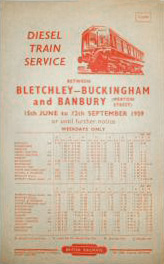
The timetable starting June 15, 1959 is shown. Before it closed, Regional boundary changes meant that Banbury Merton Street station was transferred to the Western Region, and the branch services also appeared in the WR timetable as a connection with Oxford - Bletchley trains.
The East Midland Area TUCC would finally recommend the withdrawal proposal at their September 1959 meeting after several deferments and a re-costing. It then had to be passed to the Central TUCC for approval, but the LMR started planning to withdraw the Banbury - Buckingham services from January 2, 1960 regardless.
Closure notices were posted on the Buckingham - Banbury branch stations. On Saturday 12/11/59 a Bletchley - Banbury 2-car train was noted as packed to capacity taking shoppers into Banbury and back, ironically with most of the passengers on the section of line that was closing.[6]
The January date for withdrawal of the passenger service on the Banbury - Buckingham section was cast in doubt in November when the Central TUCC agreed to allow the withdrawal, but only when a suitable replacement bus service was in place. However the local bus company, the Birmingham & Midland Motor Omnibus Company, were unwilling to run this service without a long term assurance of a subsidy, which was against British Transport Commission directives.
Other traction appeared on the line from time to time. An image on page 36 of the June 1983 Rail Enthusiast shows a two-car 'blue square' Derby Lightweight (later Class 108) set in Banbury Merton Street with a Buckingham service on Saturday December 5, 1959, no doubt one of the nine sets that Bletchley had at the time for Oxford - Cambridge services.
The passenger numbers and receipts for 1959: January, February, March, April, May, June, July, August, September, October, November and December. There was also an adjustment correcting some figures which gave a summary of August 1958 to March 1959. Figures on average saw a small decrease over the previous year.
Reprieve
Still without Central TUCC approval to withdraw the services, the line had to be given a last minute reprieve, the closure was postponed indefinitely until the bus situation could be resolved. On the date scheduled for closure, 2/1/60, a single car was noted as suffice for the traffic, with most of the passengers appearing to be riding for pleasure. Passenger loadings was also noted as being very light.[7]
Negotiations with the TUCC and bus company continued, the withdrawal proposal was resubmitted without including a bus replacement, and by March 1960 the bus company decided to lower their costs, although they would still require a subsidy.

On 23/4/60 the steam loco on the Buckingham - Bletchley service broke down, and the spare diesel single car was used in it’s place. All trains ran through from Banbury to Bletchley, removing the need to transfers at Buckingham, something that had been advocated since the services had been dieselised. The early afternoon train from Bletchley and Buckingham arrived in Banbury almost full, although later workings were never more than half full. It was noted that Banbury (Merton Street) station was beginning to look shabby, with paint pealing from the roof supports, and the two diesels, although repainted recently into olive green, were also looking the worse for wear.[8]
Double bubble - the image shows M79901 and M79900 at Brackley with the 3.45pm Banbury - Buckingham service on August 6th, 1960. Michael Mensing.
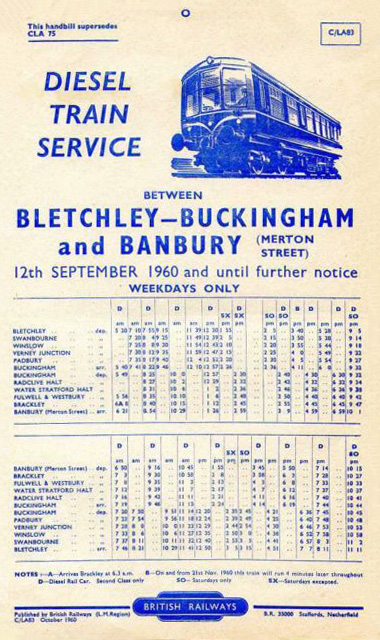
The final timetable began on 12th September 1960.
The passenger numbers and receipts for 1960: January, February and March. March was the last set of figures published in the LWTC minutes.
The End
With closure approval finally granted, a new closure date of January 2nd 1961 was set. This was a Monday, and without a Sunday service the last trains ran on Saturday December 31st 1960.
The twelve month experiment - condemned after three months - had lasted fifty-one months. The diesels had reduced the annual loss from £14,000 to £4,700 a year, far better than expected, but not enough.
The two vehicles took over from steam on the Buckingham - Bletchley services. On May 18th 1963 M79900 was noted on the 3.11pm arrival at Bletchley towing delapidated cafeteria car M261M.[9]
The Buckingham - Verney Junction section would close on 7th September 1964, after which they could be found on Oxford - Bletchley (and Cambridge?) services, sometimes paired with a Derby Lightweight DMC.
M79900 would be transferred to York as a route learning vehicle in September 1967. M79901 would be withdrawn at the end of 1966 and cut up at Bletchley depot in April 1967, some of its passenger seats would find their way into the shunters cabin[10].
Post-Experiment Critisism
When the branch closed there was criticism of the way the experiment was handled. It was felt that operating the diesel cars in conjunction with steam on the Buckingham to Bletchley service was unjustifiable. The steam auto-train was idle for long periods and the diesels were far from fully utilised and ran idle to and from the fuelling point at Bletchley. It was thought that the two diesels could easily have taken over a slightly modified service, dispensing with steam.
In 1960 the service gave only two through trains per day between Bletchley and Banbury, with three in the opposite direction and one extra each way on Sundays. All other through passengers required up to a 30 minute wait for a connection at Buckingham. Another point that was criticised was that the latest a passenger could leave Euston to reach any of the branch stations was 14:50 on Mondays to Fridays, which did not encourage day return custom to London.
It was felt that instead of the two new halts that were built there should have been a halt serving the Buckingham housing estate, and possibly one on the outskirts of Bletchley where huge housing estates were growing up alongside the line. Also, had a bay platform been added for branch trains at Banbury General during its reconstruction, it would have allowed the closure of Merton Street and would have saved a considerable walk between the stations for passengers with connections.
References
- ⋏ Banbury Merton Street station, Wikipedia, accessed December 2nd, 2019
- ⋏ September 1956, p331 Railway Observer
- ⋏ Trains Illustrated, December 1959, p595, Ian Allan
- ⋏ December 1958, p379 Railway Observer
- ⋏ August 1959, p237 Railway Observer
- ⋏ January 1960, p10 Railway Observer
- ⋏ February 1960, p43 Railway Observer
- ⋏ June 1960, p181 Railway Observer
- ⋏ July 1963, p207 Railway Observer
- ⋏ Email Graham Baker (Bletchley driver) to Stuart Mackay 17 September 2022
The Railway Observer is the journal of the Railway Correspondence and Travel Society
Summary
Description
- Single cars
- Four-car sets
Drivers Instructions
Numbering
Liveries
Operations
- West Cumberland
- Lincolnshire
- East Anglia
- North Eastern Region
- Buckingham - Banbury
- Manchester
Non-Passenger Use
- Special Saloon
- Ultrasonic Test Train
Images
Details about preserved Derby Lightweights can be found here.


